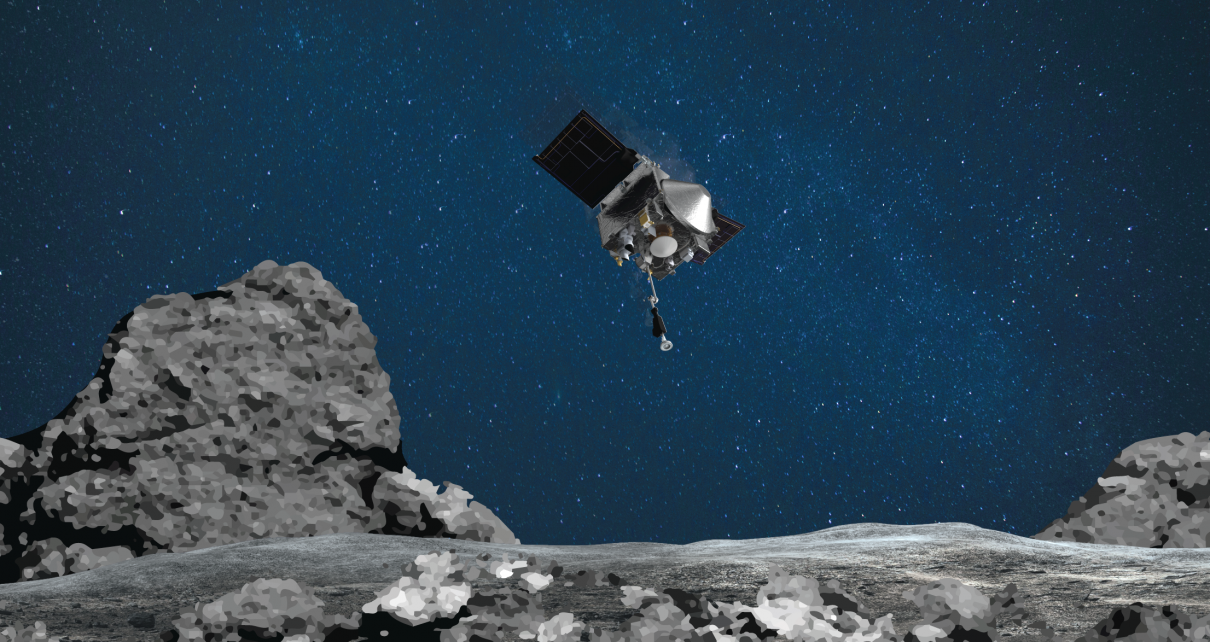On the other side of the sun, an interplanetary heist is afoot. Next week NASA’s OSIRIS-REx spacecraft will make a daring attempt to steal samples from the surface of an asteroid, dodging giant boulders and other hazards in the process. If all goes well, it will then make the long journey back home, returning the largest amount of extraterrestrial material to Earth from a nonlunar mission in history. Its precious cargo of otherworldly rocks could hold answers to long-standing questions about our cosmic origins. “We hope to get material that will inform us about the first phase of our solar system’s formation,” says Patrick Michel of the Côte d’Azur Observatory in France.
The roughly $1-billion OSIRIS-REx was launched back in 2016 on a mission to the asteroid Bennu, which has an orbit slightly larger than Earth’s. Equipped with an extendable armlike instrument called the Touch-and-Go Sample Acquisition Mechanism (TAGSAM), the primary goal of the spacecraft is to descend to Bennu’s surface and scoop up a sizable amount of sample, up to two kilograms, before returning to Earth. The only previous successful asteroid-sample-return mission, Japan’s Hayabusa, returned just a few micrograms in 2010. Its successor, Hayabusa2, is scheduled to drop off a new sample in December but with only up to a gram onboard.
OSIRIS-REx has been nearly two decades in the making, says Dante Lauretta, a planetary scientist at the University of Arizona, who is the mission’s principal investigator. “I’ve been working on this for over 16 years,” he says. And now the moment of reckoning has arrived. This Tuesday, October 20, at about 1:50 P.M. EST, mission controllers will command the spacecraft to begin its autonomous approach to Bennu from its parking orbit 700 meters above the surface. Over the next four and a half hours, it will slowly descend and make its way toward a preselected landing site called Nightingale. Then, at about 6:10 P.M. EST, the spacecraft should touch the surface for no more than 15 seconds, sucking up a sample before making its escape.
OSIRIS-REx and Bennu are currently on the other side of the sun, about 334 million kilometers from Earth. That means it takes 18 minutes to communicate one way with the spacecraft, necessitating the autonomous nature of the landing. But the mission’s team is well prepared: in August it completed the second of two landing rehearsals, in which the spacecraft approached to just 131 feet (40 meters) from the landing site before backing away. This rehearsal included a test of the spacecraft’s ability to use visual images to make its way to the surface.
An overview of OSIRIS-Rex’s Touch-And-Go (TAG) sample collection event, slated to occur at asteroid Bennu on Oct. 20, 2020. Credit: NASA’s Goddard Space Flight Center
Originally, the scientists had planned to use laser tracking to touch down at Bennu. But upon arrival, they discovered it was a “rubble pile” asteroid, meaning it was composed of a lot of rocks of varying sizes. This quality would make landing via laser difficult because the beam’s light would be scattered by the asteroid’s surface. Instead the team decided to employ the spacecraft’s cameras to guide the touchdown at Nightingale, a relatively flat 16-meter-wide region among the rubble. “We’re basically trying to park a large van in a spot that’s two parking spaces wide,” Lauretta says.
Bennu’s structure and composition have been of keen interest since OSIRIS-REx arrived. Last week a series of papers published in the journals Science and Science Advances detailed some new findings about the asteroid, based on data from the spacecraft. In one of the studies, scientists describe the presence of organic carbon-bearing material on Bennu’s surface. “Organic carbon is interesting because we think asteroids like Bennu could have delivered organic matter to early Earth,” says Hannah Kaplan of NASA’s Goddard Space Flight Center, who is lead author of one of the recent studies and a co-author of another. “So to be able to go back and look at what these very early pristine organic materials look like, that’s really exciting.”
In another of the papers, scientists were able to use OSIRIS-REx’s images of material ejected from the surface of Bennu to work out its interior composition and gravity. After the spacecraft arrived at the asteroid in 2018, scientists were surprised to discover that Bennu was actively ejecting particles into space that remained in orbit around it. “We used this ‘particle gravity field’ to analyze how the mass is distributed within Bennu,” says Daniel Scheeres of the University of Colorado Boulder, who was lead author of the study. The researchers found the interior of the asteroid was heterogeneous, meaning some parts were more dense than others—something that could account for the Bennu’s odd bulgelike shape, too. Pulled by the asteroid’s rotation, “material is flowing down into the equatorial region, albeit relatively slowly,” Scheeres says.
The rubble-pile nature of Bennu adds some complexity to OSIRIS-REx’s landing. The first major milestone will come about four hours after leaving its parking orbit, when the spacecraft will start its “checkpoint burn”: it will use its thrusters to come to a momentary halt 410 feet (125 meters) above the Nightingale landing site before beginning its descent. About 11 minutes later, OSIRIS-REx will slow its descent to the surface with a “matchpoint burn,” ultimately reducing its speed to just 10 centimeters per second, with its TAGSAM arm extended out toward the asteroid.
When the arm touches the surface, a spring system inside will slow the spacecraft’s relative velocity to zero. The arm’s circular collector head will remain in contact with Bennu for up to 15 seconds, pumping nitrogen gas into the surface to kick up material for collection. The spring will then recoil and push the OSIRIS-REx away like a pogo stick before the craft fires its thrusters and returns to its parking orbit above the asteroid’s surface. Owing to COVID-19 restrictions, much of the OSIRIS-Rex team will watch the action unfold from the comfort of home, save for about a dozen people at mission control.
The procedure is not without its nail-biting perils. First, the spacecraft must check that there are no hazardous rocks on the surface below before beginning its descent. It will autonomously make the call on the fly, just before the matchpoint burn. The team will also be hoping the TAGSAM arm does not touch any inconveniently angled rock on the surface, which could tilt the entire spacecraft askew. The biggest danger in this scenario is a nearby massive boulder, nicknamed “Mount Doom,” that would prove deadly if OSIRIS-REx were to crash into it on the spacecraft’s ascent. “The worst-case scenario is: you come in right next to Mount Doom, tip over right toward it and fire your thrusters, and slam into that rock,” Lauretta says.
If all goes to plan, the team expects to collect anywhere from 60 grams to two kilograms of material inside the collector head. By spinning the spacecraft with the arm extended, the researchers will be able to measure the sample’s inertia and work out how much of Bennu they have collected with an accuracy of plus or minus 20 grams. If there is deemed to be enough, 60 grams or more, the spacecraft will store the collector head inside a container designed to bring the sample safely through Earth’s atmosphere. If no samples have been collected, the spacecraft has enough nitrogen gas onboard to attempt up to two more landings in December or January. In the event that Nightingale is disturbed by the spacecraft’s thrusters, those landings will occur at a second site called Osprey.
If, however, enough samples are collected from Nightingale—which the team will decide on October 30—the spacecraft will remain in orbit until March 2021 and then depart Bennu on a voyage home. In September 2023 it will arrive back at our planet and drop its capsule into our atmosphere. The capsule will then parachute to safety in the Utah desert with its scientific spoils in tow. But before all that, there is the small matter of actually putting the most crucial part of this grand and elaborate plan in action. “The biggest disappointment is that the team cannot gather to celebrate this event,” says Lauretta, who is instead now eyeing the spacecraft’s late 2023 return to Earth for some revelry. “We better be over the pandemic by then.”




